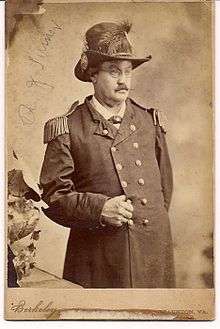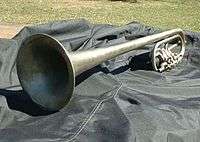A. J. Turner
| Augustus John Turner | |
|---|---|
 Turner in Staunton, Virginia. | |
| Nickname(s) | A. J. |
| Born |
October 12, 1818 Spartanburg County, South Carolina, U.S. |
| Died |
May 14, 1905 (aged 86) Indianapolis, Indiana, U.S. |
| Allegiance |
|
| Service/branch |
|
| Years of service | 1862 |
| Rank | Chief Musician |
| Unit | Company Band, 5th Virginia Infantry |
| Battles/wars | |
| Spouse(s) | Kate M. Aby |
| Relations |
Charles W. Turner (son) Thomas Memory Turner (son) Cora Turner Freijs (daughter) |
Augustus John Turner, (October 12, 1818 – May 14, 1905), known as "A. J. Turner", was an American composer, band leader and music professor. He was the first director of the Stonewall Brigade Band of Staunton, Virginia,[1][2][3][4] the oldest continuous community band funded by tax moneys in the United States.[5] Turner was a professor of music at both the Wesleyan Female Institute and the Deaf, Dumb, and Blind Institute, and he played a part in the temperance movement.
Early years
Augustus John Turner was born on October 12, 1818, in Spartanburg County, South Carolina, to Samuel M. Turner, a farmer, and Mahala Johnson Chapman.[3][6] Both his grandfathers fought in the American Revolution.[3][n 1]
Staunton
Before moving to Staunton, Turner lived in Middletown and Newtown, near Winchester in Frederick County, Virginia. He married Catherine ("Kate") Montrose Aby on July 1, 1845, in Frederick County.[7][n 2] Turner's house in Newtown was destroyed in a fire on December 2, 1856.[8] His former house in Staunton sold for $3,350 soon after his death.[9]
Stonewall Brigade Band

In Staunton, Virginia, in 1855, David W. Drake sought to found a band. He enlisted the help of Turner, his former music teacher in Newtown, persuading him to move to Staunton.[5][10] Together with two other citizens of Staunton, they formed the Mountain Saxhorn Band.[11][12][13] They gave their first formal concert on July 17, 1857, at Union Hall on Beverley Street in Staunton. By 1859 the band had come to be known as Turner's Silver Cornet Band.[14][15][16] At Armory Hall on April 4, 1861, Turner's Silver Cornet Band, together with the Staunton Musical Association and the Glee Club, presented the last concert to be given before the Civil War.
Civil War
The band was mustered into the 5th Virginia Infantry Regiment under Stonewall Jackson and Colonel William S. Baylor.[17] Soon after the Battle of First Manassas, the band earned the name Stonewall Brigade Band,[18] and has been known as such ever since. As well as playing their instruments, band members fought and acted as couriers and letter bearers[19] or medical assistants.[18] Turner's first son Charles was a courier.[20] In addition to entertaining the troops in the field, the band frequently appeared in concerts in Fredericksburg, Richmond, Staunton, and elsewhere to support recruiting rallies, clothing drives, and war relief fundraising.
Turner enlisted for the Confederacy on April 1, 1862.[21] He was in the 14th Virginia Infantry Company I for a time, before transferring into the 5th. He was discharged because of his age on August 22, 1862. One engagement this places him at is the Battle of Cedar Mountain.[22][23]
Post-war
The band was reorganized in 1869 with Turner as leader and his son T. M. Turner as assistant leader.[24] A. J. Turner directed the band until 1884.[21]
Music teacher
Turner could play many instruments.[25] An 1896 advert for his services reads, "Prof. A. J. Turner respectfully solicits a class of young people of both sexes in music ... Instruments: violin, piano, guitar, mandolin, cello and cornet."[26] He was also an agent for the sale of Stieff pianos.[5][27][28]
Wesleyan Female Institute
Turner's first job in Staunton was teaching vocal and instrumental music at the Wesleyan Female Institute.[5][29]
Deaf, Dumb, and Blind Institute
Turner was appointed professor of music at the Deaf, Dumb, and Blind Institute in November 1866 and served there for several decades, teaching the blind pupils.[30][31][32][33] One account of the institute's annual concert praises the pupils for "a high degree of musical taste and talent".[34] His salary was increased $200 in 1871.[35]
Temperance
Turner was active in the temperance movement and in 1878 was the Most Worthy Grand Chief of the Sons of Jonadab.[21][36]
Indianapolis
Turner left for Indianapolis, Indiana, in 1900 to live with his daughter Cora Turner Freijs.[37] He would reside there until his death.[38][39]
List of compositions
- "Gallopade", 1857[5]
- "At Eve Beneath Stars' Soft Light: or Memories of Old", 1858[40]
- "Bessie Bell Waltz", 1858[41]
- "Pray Maiden, Pray", 1864[42]
- "Palmetto Schottisch", 1864[43]
- "Spring time polka", 1864[44]
- "La Perle", 1875[45]
- "Peyton Summerson's Funeral March", 1879[46]
Notes
- ↑ One grandmother was the sister of Jammie Seay.
- ↑ Her father was a shoemaker and veteran of the War of 1812; her mother the daughter of a drummer in the American Revolution.
References
- ↑ Zenas J Grey (October 4, 1881). "The Blue and the Gray at Carlisle, PA". Staunton Spectator.
- ↑ "Handsomely Done". Staunton Spectator. June 3, 1885.
- 1 2 3 J. B. O. Landrum. History of Spartanburg County. p. 407.
- ↑ "A Band of 1845 (sic)". Popular Science. March 1935.
- 1 2 3 4 5 "Stonewall Brigade Band". Archived from the original on March 3, 2016. Retrieved February 28, 2015.
- ↑ "Obituary". Spartanburg Herald. June 11, 1879. p. 3.
- ↑ Dodd, Jordan R., et al.. Early American Marriages: Virginia to 1850. Bountiful, UT, USA: Precision Indexing Publishers.
- ↑ "Fire Near Winchester". Richmond Whig. December 2, 1856.
- ↑ "Local Briefs". Staunton spectator and vindicator. August 25, 1905.
- ↑ "Deaths During the Week". Staunton Spectator and vindicator. October 29, 1909.
- ↑ Marshall Moore Brice. The Stonewall Brigade Band. p. 9.
- ↑ Acts of the General Assembly of the Commonwealth of Virginia. 3. p. 2583.
- ↑ J. A. Hiner. "The Stonewall Brigade Band". Confederate Veteran: Published Monthly in the Interest of Confederate Veterans and Kindred Topics. 8: 304.
- ↑ "The Concert". Staunton Vindicator. June 1, 1860. p. 2.
- ↑ "Staunton's Stonewall Brigade Band". Retrieved February 28, 2015.
- ↑ "We call attention to the advertisement...". Republican Vindicator. June 4, 1859.
- ↑ John Overton Casler. Four Years in the Stonewall Brigade. p. 48.
- 1 2 James I. Robertson. The Stonewall Brigade. p. 47.
- ↑ The Civil War Paintings of Mort Künstler. p. 142.
- ↑ William Couper. The Corps Forward. p. 209.
- 1 2 3 "Soldiers Records". Retrieved February 28, 2015.
- ↑ U.S., American Civil War Regiments, 1861-1866 [database on-line]. Provo, UT, USA: Ancestry.com Operations Inc, 1999.
- ↑ Marshall Moore Brice. The Stonewall Brigade Band. p. 32.
- ↑ "Reorganized". Republican Vindicator. November 19, 1869.
- ↑ "NOTED BANDMASTER DEAD". Harrisonburg Daily News. May 18, 1905. p. 5.
- ↑ "Music". Staunton Spectator. September 9, 1896.
- ↑ "Pianos, Pianos, Pianos!". Staunton Spectator. December 26, 1865.
- ↑ "Pianos, Pianos.". Staunton Spectator. April 17, 1866.
- ↑ "Wesleyan Female Institute". Staunton Spectator. July 5, 1870.
- ↑ Virginia School for the Deaf and the Blind, Staunton (1876). Report.
- ↑ Virginia School for the Deaf and the Blind, Staunton (1886). Report.
- ↑ "Local News". Staunton Spectator. November 13, 1866. p. 3.
- ↑ "Concert By The Blind Pupils". Staunton Spectator. June 30, 1868.
- ↑ "[No Title]". Staunton Spectator. June 28, 1870.
- ↑ "D. D. & B. Institution". Staunton Spectator. August 8, 1871.
- ↑ "Briefs". Staunton Spectator. May 21, 1878.
- ↑ "Personal". Staunton Spectator.
- ↑ "Virginia News". Alexandria Gazette. May 17, 1905.
- ↑ "Death of Prof. A. J. Turner". Shenandoah Herald. May 26, 1905.
- ↑ "New Music-Good Music". Staunton Spectator. March 1, 1859. p. 2.
- ↑ "Bessie Bell Waltz". June 15, 1858. p. 3.
- ↑ "Pray Maiden Pray". Retrieved February 28, 2015.
- ↑ "To the ladies of the Confederate States : Palmetto schottisch". Retrieved February 28, 2015.
- ↑ "Spring time polka". Retrieved February 28, 2015.
- ↑ "La Perle". Retrieved February 28, 2015.
- ↑ "Memorial Day at Staunton". Staunton Spectator. June 10, 1879.